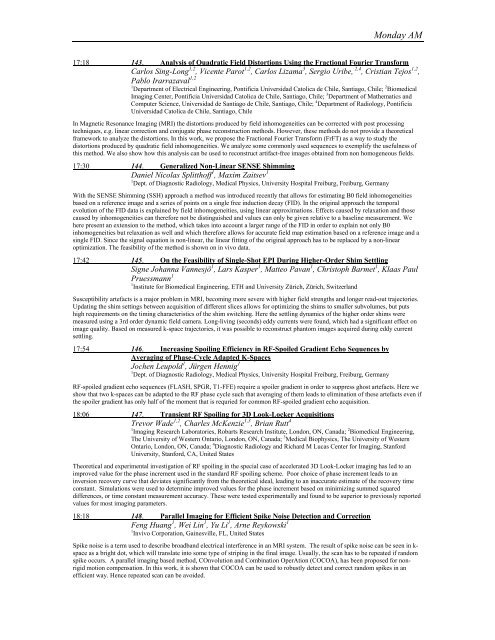OPENING SESSION - ismrm
OPENING SESSION - ismrm
OPENING SESSION - ismrm
You also want an ePaper? Increase the reach of your titles
YUMPU automatically turns print PDFs into web optimized ePapers that Google loves.
Monday AM<br />
17:18 143. Analysis of Quadratic Field Distortions Using the Fractional Fourier Transform<br />
Carlos Sing-Long 1,2 , Vicente Parot 1,2 , Carlos Lizama 3 , Sergio Uribe, 2,4 , Cristian Tejos 1,2 ,<br />
Pablo Irarrazaval 1,2<br />
1 Department of Electrical Engineering, Pontificia Universidad Catolica de Chile, Santiago, Chile; 2 Biomedical<br />
Imaging Center, Pontificia Universidad Catolica de Chile, Santiago, Chile; 3 Department of Mathematics and<br />
Computer Science, Universidad de Santiago de Chile, Santiago, Chile; 4 Department of Radiology, Pontificia<br />
Universidad Catolica de Chile, Santiago, Chile<br />
In Magnetic Resonance Imaging (MRI) the distortions produced by field inhomogeneities can be corrected with post processing<br />
techniques, e.g. linear correction and conjugate phase reconstruction methods. However, these methods do not provide a theoretical<br />
framework to analyze the distortions. In this work, we propose the Fractional Fourier Transform (FrFT) as a way to study the<br />
distortions produced by quadratic field inhomogeneities. We analyze some commonly used sequences to exemplify the usefulness of<br />
this method. We also show how this analysis can be used to reconstruct artifact-free images obtained from non homogeneous fields.<br />
17:30 144. Generalized Non-Linear SENSE Shimming<br />
Daniel Nicolas Splitthoff 1 , Maxim Zaitsev 1<br />
1 Dept. of Diagnostic Radiology, Medical Physics, University Hospital Freiburg, Freiburg, Germany<br />
With the SENSE Shimming (SSH) approach a method was introduced recently that allows for estimating B0 field inhomogeneities<br />
based on a reference image and a series of points on a single free induction decay (FID). In the original approach the temporal<br />
evolution of the FID data is explained by field inhomogeneities, using linear approximations. Effects caused by relaxation and those<br />
caused by inhomogeneities can therefore not be distinguished and values can only be given relative to a baseline measurement. We<br />
here present an extension to the method, which takes into account a larger range of the FID in order to explain not only B0<br />
inhomogeneities but relaxation as well and which therefore allows for accurate field map estimation based on a reference image and a<br />
single FID. Since the signal equation is non-linear, the linear fitting of the original approach has to be replaced by a non-linear<br />
optimization. The feasibility of the method is shown on in vivo data.<br />
17:42 145. On the Feasibility of Single-Shot EPI During Higher-Order Shim Settling<br />
Signe Johanna Vannesjö 1 , Lars Kasper 1 , Matteo Pavan 1 , Christoph Barmet 1 , Klaas Paul<br />
Pruessmann 1<br />
1 Institute for Biomedical Engineering, ETH and University Zürich, Zürich, Switzerland<br />
Susceptibility artefacts is a major problem in MRI, becoming more severe with higher field strengths and longer read-out trajectories.<br />
Updating the shim settings between acquisition of different slices allows for optimizing the shims to smaller subvolumes, but puts<br />
high requirements on the timing characteristics of the shim switching. Here the settling dynamics of the higher order shims were<br />
measured using a 3rd order dynamic field camera. Long-living (seconds) eddy currents were found, which had a significant effect on<br />
image quality. Based on measured k-space trajectories, it was possible to reconstruct phantom images acquired during eddy current<br />
settling.<br />
17:54 146. Increasing Spoiling Efficiency in RF-Spoiled Gradient Echo Sequences by<br />
Averaging of Phase-Cycle Adapted K-Spaces<br />
Jochen Leupold 1 , Jürgen Hennig 1<br />
1 Dept. of Diagnostic Radiology, Medical Physics, University Hospital Freiburg, Freiburg, Germany<br />
RF-spoiled gradient echo sequences (FLASH, SPGR, T1-FFE) require a spoiler gradient in order to suppress ghost artefacts. Here we<br />
show that two k-spaces can be adapted to the RF phase cycle such that averaging of them leads to elimination of these artefacts even if<br />
the spoiler gradient has only half of the moment that is requried for common RF-spoiled gradient echo acquisition.<br />
18:06 147. Transient RF Spoiling for 3D Look-Locker Acquisitions<br />
Trevor Wade 1,2 , Charles McKenzie 1,3 , Brian Rutt 4<br />
1 Imaging Research Laboratories, Robarts Research Institute, London, ON, Canada; 2 Biomedical Engineering,<br />
The University of Western Ontario, London, ON, Canada; 3 Medical Biophysics, The University of Western<br />
Ontario, London, ON, Canada; 4 Diagnostic Radiology and Richard M Lucas Center for Imaging, Stanford<br />
University, Stanford, CA, United States<br />
Theoretical and experimental investigation of RF spoiling in the special case of accelerated 3D Look-Locker imaging has led to an<br />
improved value for the phase increment used in the standard RF spoiling scheme. Poor choice of phase increment leads to an<br />
inversion recovery curve that deviates significantly from the theoretical ideal, leading to an inaccurate estimate of the recovery time<br />
constant. Simulations were used to determine improved values for the phase increment based on minimizing summed squared<br />
differences, or time constant measurement accuracy. These were tested experimentally and found to be superior to previously reported<br />
values for most imaging parameters.<br />
18:18 148. Parallel Imaging for Efficient Spike Noise Detection and Correction<br />
Feng Huang 1 , Wei Lin 1 , Yu Li 1 , Arne Reykowski 1<br />
1 Invivo Corporation, Gainesville, FL, United States<br />
Spike noise is a term used to describe broadband electrical interference in an MRI system. The result of spike noise can be seen in k-<br />
space as a bright dot, which will translate into some type of striping in the final image. Usually, the scan has to be repeated if random<br />
spike occurs. A parallel imaging based method, COnvolution and Combination OperAtion (COCOA), has been proposed for nonrigid<br />
motion compensation. In this work, it is shown that COCOA can be used to robustly detect and correct random spikes in an<br />
efficient way. Hence repeated scan can be avoided.















